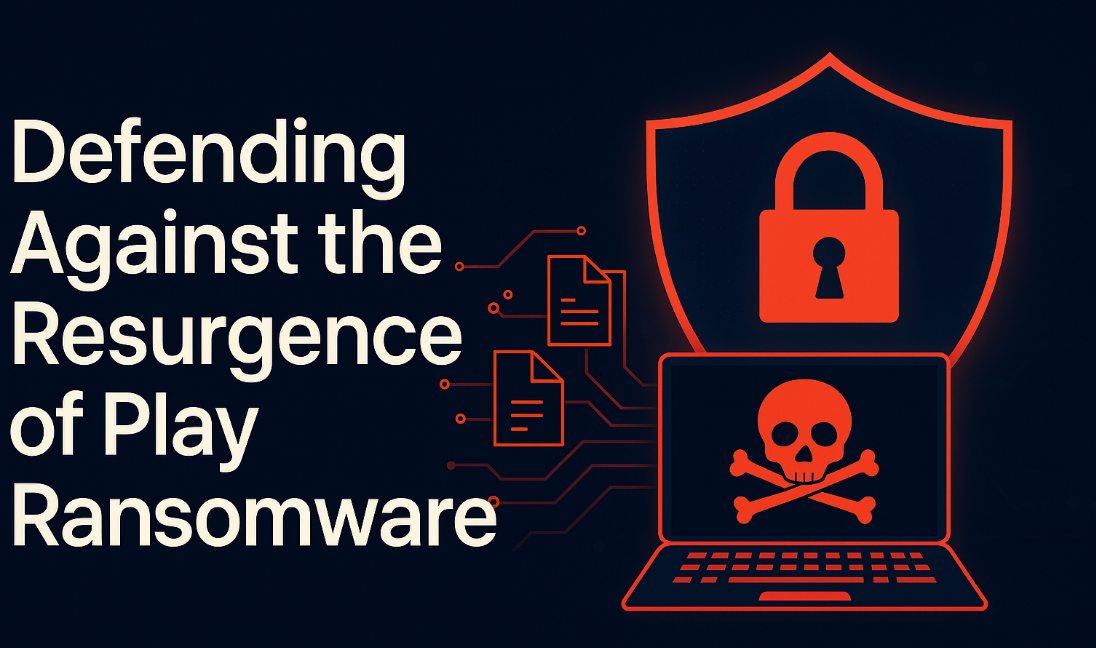The Play ransomware group, also known as PlayCrypt, continues to be a high-impact cyber threat in 2025. Following its initial emergence in mid-2022, this ransomware-as-a-service (RaaS) operation has successfully targeted over 900 organizations globally, exploiting both technical and human vulnerabilities. As CISOs, understanding the evolving tactics, techniques, and procedures (TTPs) of such actors is paramount to ensuring proactive defense and resilient incident response strategies.
In its latest update on June 4, 2025, the U.S. Cybersecurity and Infrastructure Security Agency (CISA), the FBI, and Australia’s ASD jointly issued a comprehensive advisory detailing the Play group’s newly observed capabilities. Notably, Play’s operations have expanded to include exploitation of newly disclosed vulnerabilities, the deployment of customized binaries for each attack, and aggressive social engineering, including post-breach telephone extortion tactics.
Key Technical Insights
Initial Access is often gained through compromised credentials, purchased via the dark web, or by exploiting known vulnerabilities in public-facing systems. Particularly, Fortinet (CVE-2018-13379), Microsoft Exchange (CVE-2022-41040/41082), and most recently SimpleHelp RMM software (CVE-2024-57727) have been primary vectors.
Defense Evasion remains sophisticated: Play actors employ tools like GMER, PowerTool, and PowerShell scripts to disable Microsoft Defender and other endpoint protections. Log cleansing via T1070.001 techniques is also routinely executed.
Credential Access and Privilege Escalation are executed with standard tools like Mimikatz, WinPEAS, and PsExec, achieving domain admin-level access before lateral movement through Group Policy Object (GPO) injection and SystemBC C2 frameworks.
Data Exfiltration and Encryption are carried out via tools such as WinRAR and WinSCP, followed by AES-RSA hybrid encryption. A hallmark .PLAY file extension signals system compromise. Crucially, each binary is unique per deployment—hindering traditional signature-based detections.
Play’s Psychological Warfare
A defining characteristic of Play is its double extortion methodology. Beyond file encryption, data is exfiltrated and victims—ranging from SMEs to critical infrastructure providers—are pressured via threatening phone calls. These calls are made using publicly scraped contact lists, often reaching help desks or executives, to amplify urgency and force payment. Victims are instructed to respond via individualized @gmx.de or @web.de email addresses—eschewing automated portals or fixed ransom amounts.
ESXi Variant Expands Reach
The group has extended operations to VMware ESXi systems. Their Linux-based payloads issue shell commands to power off virtual machines before encrypting key files (.vmdk, .vmem, .vmx, etc.) using AES-256. Interestingly, the malware can exempt specific machines, indicating a tailored and manually guided campaign approach. These binaries also manipulate ESXi welcome messages—signaling compromise even before ransom notes are opened.
Tools of the Trade
While many ransomware actors rely on known commodity malware, Play’s arsenal includes both customized tools (e.g., Grixba) and legitimate IT utilities repurposed for malicious ends. Cobalt Strike, BloodHound, Plink, and Process Hacker remain prevalent—reinforcing the need for robust behavior-based detection systems.
What CISOs Must Do Immediately
CISOs must translate intelligence into concrete actions. Based on the advisory, immediate priorities include:
- MFA Enforcement: Mandate MFA, especially for webmail, VPN, and privileged access accounts.
- Patch Management: Patch all systems promptly, especially those with known exploited vulnerabilities.
- Network Segmentation: Implement granular access controls and isolate high-value assets.
- EDR Deployment: Ensure full visibility across endpoints, with heuristic anomaly detection.
- Backup Strategy: Maintain offline, immutable backups tested regularly under real-world recovery scenarios.
- User Awareness: Train frontline personnel—especially help desks—to recognize post-attack extortion tactics.
- IOC Hunting: Deploy updated hashes and YARA rules provided by CISA to threat hunt within the environment.
Strategic Considerations for vCISOs
Given the modular nature of Play’s attacks, virtual CISOs (vCISOs) must design adaptive, scalable response plans. Emphasize:
- Zero Trust principles for all remote access
- Periodic review of privileged accounts and service accounts
- Simulation-based red-teaming to assess lateral movement resilience
Closing Thought
The resurgence of Play ransomware highlights a critical truth: ransomware operators are adapting faster than many defenders. It is no longer enough to react—CISOs must lead with a security-by-design philosophy, foster a culture of awareness, and embed intelligence into every layer of their defense strategy.
As a reminder, neither the FBI, CISA, nor ASD encourage ransom payments. Paying may fuel further attacks, without guaranteeing data recovery. Instead, use these incidents to strengthen your posture and test your resilience.
For more technical details, download the full advisory and YARA/Suricata detection rules from stopransomware.gov.

